Engine Starting Fluid, commonly known as ether, has been widely accepted as a practical aid in starting diesel engines. The use of high pressure Ether Systems is considered almost mandatory for successfully starting cold soaked diesel engines at -50°F (-46°C).
The questions of why Ether is so effective or how to apply Ether as a practical means for starting a diesel engine, can best be answered by examining the basic combustion principles of a direct injection diesel engine and how the characteristics of Ether Fluid are applicable.
There are several variables that influence the ability of a diesel engine to start. When diesel equipment is maintained in proper mechanical condition, the most influential outside sources that affect the engine’s start ability are:
- The temperature of the engine.
- The cetane rating of the diesel fuel.
- The atmospheric pressure.
The effects of cold temperature on the engine’s ability to start are quite apparent. The effect of the diesel fuel cetane index is not so obvious. Generally, as the fuel cetane index rating is lowered, the auto ignition temperature of the fuel (temperature at which the diesel fuel will burn) will be higher.
To appreciate the effects of atmospheric pressure on the ability of the engine to start, the process of compression ignition (Diesel) should be understood and not confused with the ability to start a spark-ignited engine (Gas), under similar circumstances.
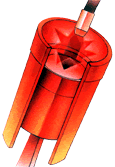
Diesel engines rely on the heat generated by the compression of the air in the combustion chamber. After the compression process creates enough heat, the gases in the combustion chamber are ignited. Some of the heat generated by combustion is absorbed into the cold metal mass of the engine. At colder temperatures, the loss or absorption of initial combustion heat through the cold metal mass of the engine is size-able.
The heat loss is further aggravated by the strain of parasitic loads on the engine during, and immediately after, start up; i.e. Power Steering Pump, Air Compressor, Viscous Fan Drives, Alternators, etc. The accumulation of these heat loss conditions effect the pressure and/or amount of air in the combustion chamber during the piston’s compression stroke. Typically the actual compression ratio during engine cranking is lower in high performance turbocharged engines as compared to naturally aspirated engines. This, in effect, raises the unaided starting threshold of the engine. In addition, with the ability to “pack” more air into the combustion chamber during peak performance after-cooling or inter-cooling has typically raised the unaided starting temperature threshold of the high performance diesels.
Engine Starting Fluid is comprised mainly of Diethyl Ether. Ether in a gaseous state has an auto ignition temperature of 360°F (182°C). On a cold soaked engine, when the air and ether vapor mixture is introduced into the engine combustion chamber, ignition will take place as the heat of compression reaches 360°F (182°C). This flame front from the burning ether vapor produces enough heat to compensate for the compression heat lost through the cold metal mass of the engine. As the piston nears the top of the compression stroke, if the heat generated by compression plus the added heat from the burning ether is sufficiently above the auto ignition temperature (725°F, 385°C), of diesel fuel, the cylinders will “Fire” and a successful cold start is achieved. (See Figure 1)
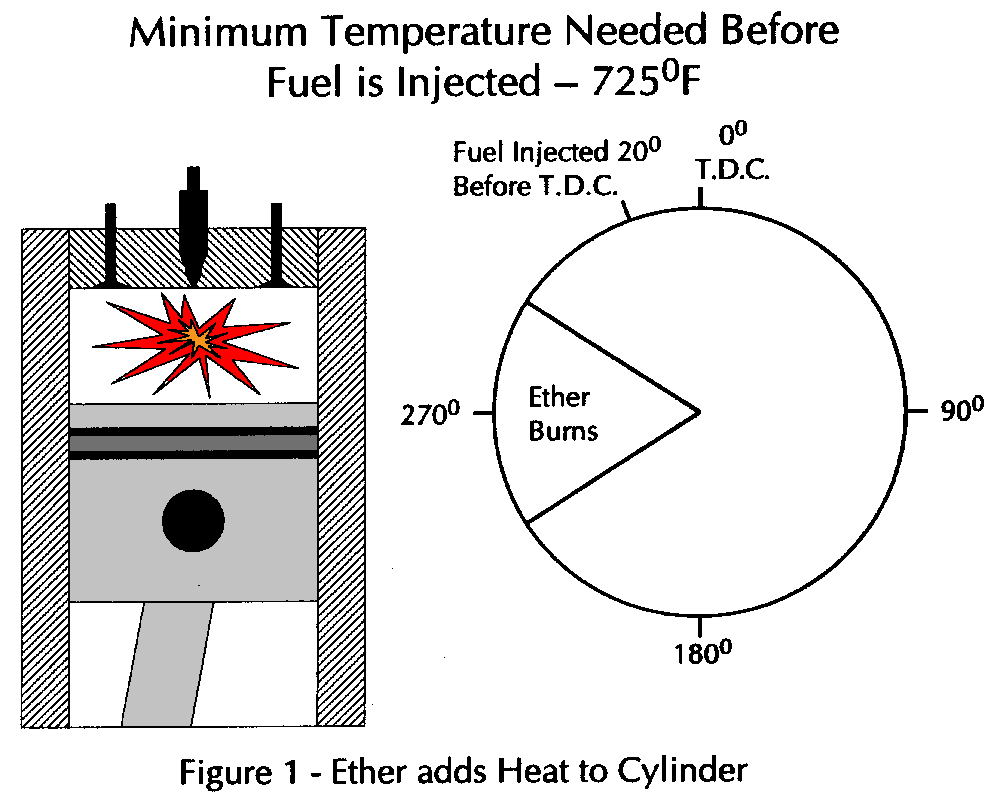
Measured Shot – How it Works:
The first available ether systems were described as Measured Shot, Operator controlled. The proprietary components of such a system are the high pressure Ether Cylinder, the Measured Shot valve and the atomizer or metering orifice (See Figure 2).
The installation of these systems generally allow the operator to determine when and how much Ether Fluid to inject into the engine. Some systems incorporate the use of a temperature “lock out” device to prevent the operator from injecting Ether Fluid into a warm engine.
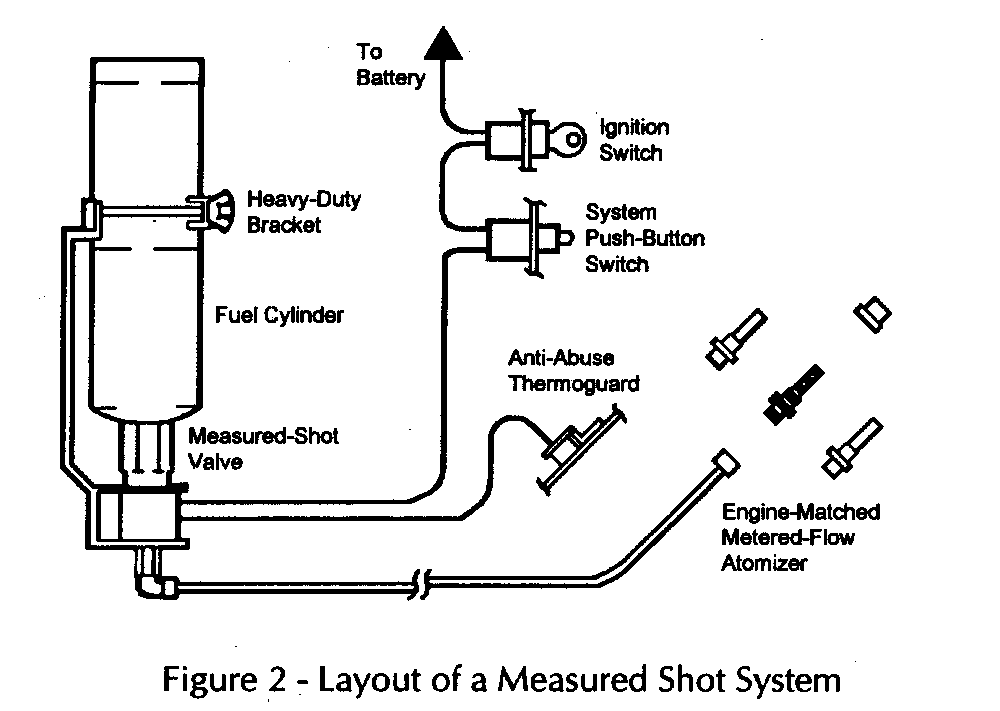
The intention of a measured shot system is to allow the operator to activate the Ether System during engine cranking. This activation takes place by pushing and releasing an electrical push button switch located on the dash adjacent to the ignition switch.
When the operator pushes the electrical button switch, the valve is activated and allows the Ether Fluid to flow from the pressurized cylinder into a predetermined measured chamber in the valve body. On a heavy-duty diesel this chamber is sized to hold 6 milliliters of Ether Fluid. The Ether Fluid is retained in the chamber until the operator releases the electrical push button, deactivating the valve (See Figure 3).
Upon deactivation this “measured shot” of Ether Fluid flows through tubing, propelled only by the head pressure of the measured chamber, to an atomizer installed in the engine’s air intake system. The atomizer’s purpose is to vaporize the Ether Fluid by forcing the Ether Fluid through a metering orifice. (For effective vaporization, a minimum of 30 PSI (2.07 Bars), pressure should be maintained at the metering orifice). Because of the transfer and capturing of the Ether Fluid in a measured shot valve chamber, a pressure drop will occur as the Ether Fluid is propelled to the atomizer. The amount of this pressure drop is dependent upon the size of the “measured shot” chamber. Maintaining a minimum of 30 PSI (2.07 Bars), pressure at the atomizer in a measured shot system is virtually impossible because of the depletion of propellant head pressure as the measured shot chamber empties (Refer to Figure 4, illustrating orifice pressure of “measured shot”).
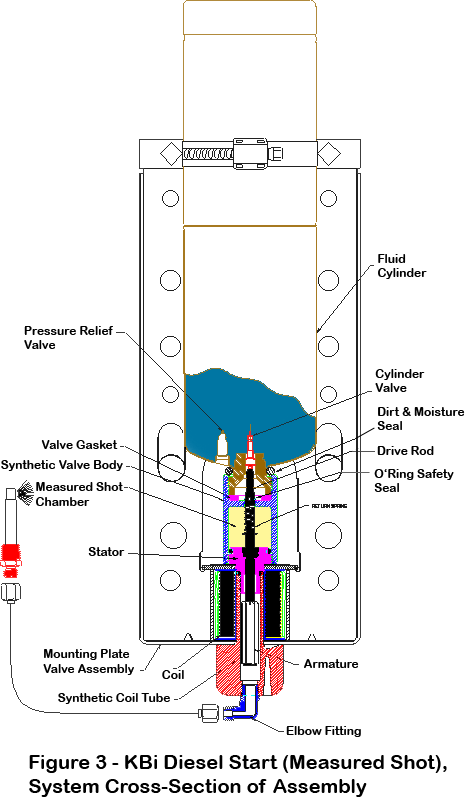
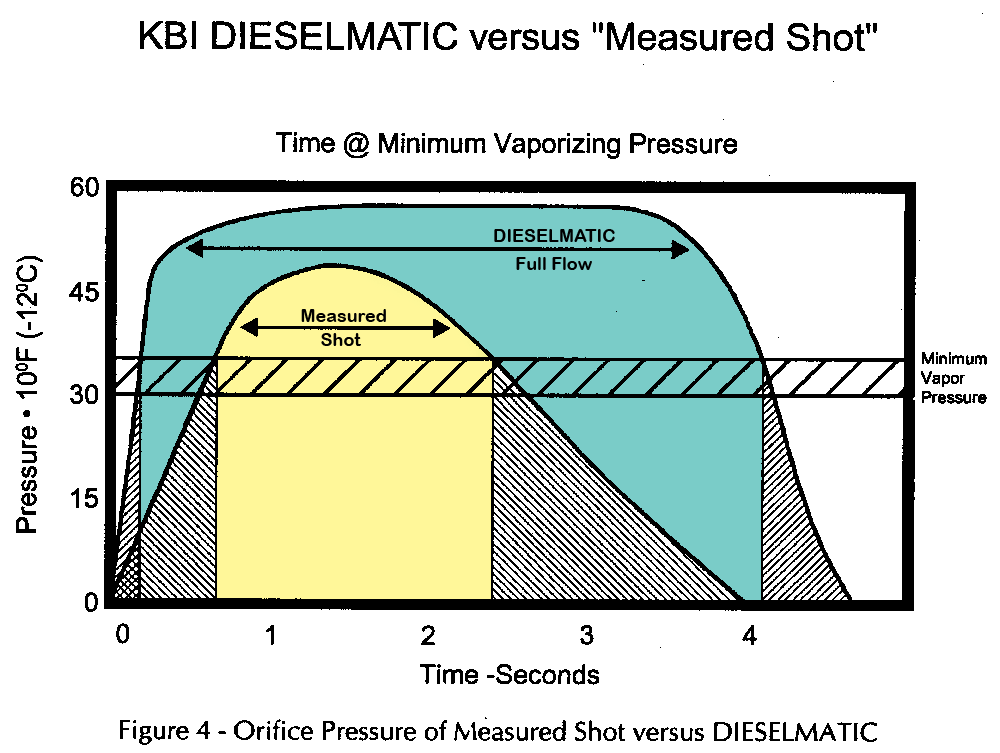
KBi DIESELMATIC® System:
A further refinement in high pressure Ether System is the introduction of a totally automatic system. A totally automatic system will allow the Ether to partially vaporize prior to injection into the engine’s air intake system. KBi is the only manufacturer to develop and market a fully automatic system using a patented, activated-flow valve in conjunction with a vaporizing fitting (BLOCKOR®). The totally automatic system is designated as the DIESELMATIC System.
The proprietary components of the DIESELMATIC system are the activated-flow valve assembly, the metering orifice (“BLOCKOR”), the engine temperature sensor (ETS), and the injector nozzle (See Figure 5).
The DIESELMATIC valve (See Figure 6) is key activated and operates only when the key is turned to the “START” position, and the cranking motor is engaged. To prevent Ether Fluid from being injected into a warm engine, the engine temperature sensor (ETS) is tied into the wiring system as an interlock if the engine block is above 40°F (4°C). The operator has absolutely NO CONTROL over the timing or quantity of Ether Fluid being injected into the engine . . .the system is “Abuse-Free”.
Since the vapor of Ether is the catalyst for diesel fuel combustion, the more effective the means of changing liquid Ether into a gaseous state, the more efficient the Ether System will be (Reference Figure 4 showing the performance of KBi DIESELMATIC versus “MEASURED-SHOT”). The DIESELMATIC System allows the pressurized Ether Fluid to begin vaporizing, through the BLOCKOR, when it leaves the valve assembly. The Ether Fluid continues to vaporize as it travels through the conduit to the injector nozzle in the engine’s air intake system.

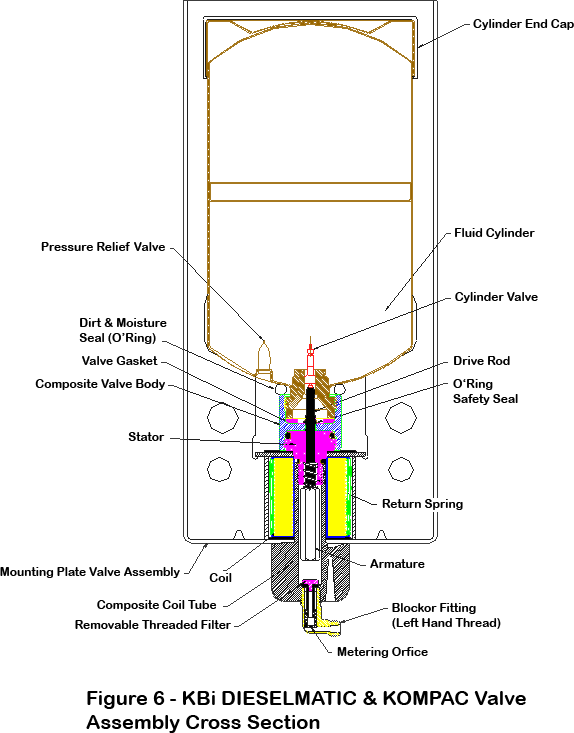
The BLOCKOR vaporizing fitting does such an effective job of vaporizing the Ether Fluid, that the DIESELMATIC System uses only ONE-FOURTH of the amount used by the “Measured-Shot” type system to affect a cold start of a diesel engine. In fact, the flow-rate of the DIESELMATIC is so small (0.475 ML/SEC); that it would be impossible to damage an engine . . . the system is “Fail-Safe”.
To continue the complete combustion process during the initial “warm up” period, it is necessary to continue the flow of Ether Fluid for several seconds after the cranking motor is disengaged. In the DIESELMATIC System, the after flow of Ether Fluid is controlled by a reservoir in the DIESELMATIC valve assembly.
The size of the Ether Cylinder on the DIESELMATIC System typically provides for a one-year’s supply, (service once per year). Also, most subzero starts with the DIESELMATIC System are attained in less than 5 seconds of cranking. An average of only 2.5 ML (1/2 teaspoon), of Ether Fluid is used, which is less than 6 1/2 cents per start . . . the system is “Economical”.
The cost of one NO-START pays for the cost of a DIESELMATIC. It is the equipment operator’s cold start assurance!

